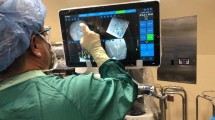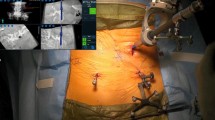Abstract
Background
Some early studies with robotic-assisted pedicle screw implantation have suggested these systems increase accuracy of screw placement. However, the relationship between the success rate of screw placement and the learning curve of this new technique has not been evaluated.
Questions/purposes
We determined whether, as a function of surgeon experience, (1) the success rate of robotic-assisted pedicle screw placement improved, (2) the frequency of conversion from robotic to manual screw placement decreased, and (3) the frequency of malpositioned screws decreased.
Methods
Between June 2010 and August 2012, the senior surgeon (IHL) performed 174 posterior spinal procedures using pedicle screws, 162 of which were attempted with robotic assistance. The use of the robotic system was aborted in 12 of the 162 procedures due to technical issues (registration failure, software crash, etc). The robotic system was successfully used in the remaining 150 procedures. These were the first procedures performed with the robot by the senior surgeon, and in this study, we divided the early learning curve into five groups: Group 1 (Patients 1–30), Group 2 (Patients 31–60), Group 3 (Patients 61–90), Group 4 (Patients 91–120), and Group 5 (Patients 121–150). One hundred twelve patients (75%) had spinal deformity and 80 patients (53%) had previous spine surgery. The accuracy of screw placement in the groups was assessed based on intraoperative biplanar fluoroscopy and postoperative radiographs. The results from these five groups were compared to determine the effect on the learning curve. The numbers of attempted pedicle screw placements were 359, 312, 349, 359, and 320 in Groups 1 to 5, respectively.
Results
The rates of successfully placed screws using robotic guidance were 82%, 93%, 91%, 95%, and 93% in Groups 1 to 5. The rates of screws converted to manual placement were 17%, 7%, 8%, 4%, and 7%. Of the robotically placed screws, the screw malposition rates were 0.8%, 0.3%, 1.4%, 0.8%, and 0%.
Conclusions
The rate of successfully placed pedicle screws improved with increasing experience. The rate of the screws that were converted to manual placement decreased with increasing experience. The frequency of screw malposition was similar over the learning curve at 0% to 1.4%. Future studies will need to determine whether this finding is generalizable to others.
Level of Evidence
Level III, therapeutic study. See the Instructions for Authors for a complete description of levels of evidence.



Similar content being viewed by others
References
Bai YS, Zhang Y, Chen ZQ, Wang CF, Zhao YC, Shi ZC, Li M, Liu KP. Learning curve of computer-assisted navigation system in spine surgery. Chin Med J (Engl). 2010;123:2989–2994.
Cahill KS, Wang MY. Evaluating the accuracy of robotic assistance in spine surgery. Neurosurgery. 2012;71:N20–N21.
Devito DP, Kaplan L, Dietl R, Pfeiffer M, Horne D, Silberstein B, Hardenbrook M, Kiriyanthan G, Barzilay Y, Bruskin A, Sackerer D, Alexandrovsky V, Stuer C, Burger R, Maeurer J, Donald GD, Schoenmayr R, Friedlander A, Knoller N, Schmieder K, Pechlivanis I, Kim IS, Meyer B, Shoham M. Clinical acceptance and accuracy assessment of spinal implants guided with SpineAssist surgical robot: retrospective study. Spine (Phila Pa 1976). 2010;35:2109–2115.
Gaines RW Jr. The use of pedicle-screw internal fixation for the operative treatment of spinal disorders. J Bone Joint Surg Am. 2000;82:1458–1476.
Hicks JM, Singla A, Shen FH, Arlet V. Complications of pedicle screw fixation in scoliosis surgery: a systematic review. Spine (Phila Pa 1976). 2010;35:E465–E470.
Hu X, Ohnmeiss DD, Lieberman IH. Robotic-assisted pedicle screw placement: lessons learned from the first 102 patients. Eur Spine J. 2013;22:661–666.
Kantelhardt SR, Martinez R, Baerwinkel S, Burger R, Giese A, Rohde V. Perioperative course and accuracy of screw positioning in conventional, open robotic-guided and percutaneous robotic-guided, pedicle screw placement. Eur Spine J. 2011;20:860–868.
Kaul S, Shah NL, Menon M. Learning curve using robotic surgery. Curr Urol Rep. 2006;7:125–129.
Kim YJ, Lenke LG, Bridwell KH, Cho YS, Riew KD. Free hand pedicle screw placement in the thoracic spine: is it safe? Spine (Phila Pa 1976). 2004;29:333–342; discussion 342.
Kotani Y, Abumi K, Ito M, Takahata M, Sudo H, Ohshima S, Minami A. Accuracy analysis of pedicle screw placement in posterior scoliosis surgery: comparison between conventional fluoroscopic and computer-assisted technique. Spine (Phila Pa 1976). 2007;32:1543–1550.
Lee MH, Lin MH, Weng HH, Cheng WC, Tsai YH, Wang TC, Yang JT. Feasibility of Intra-operative Computed Tomography Navigation System for Pedicle Screw Insertion of the Thoraco-lumbar Spine. J Spinal Disord Tech. 2012 December 3 [Epub ahead of print].
Lieberman IH, Hardenbrook MA, Wang JC, Guyer RD. Assessment of pedicle screw placement accuracy, procedure time, and radiation exposure using a miniature robotic guidance system. J Spinal Disord Tech. 2012;25:241–248.
Lieberman IH, Togawa D, Kayanja MM, Reinhardt MK, Friedlander A, Knoller N, Benzel EC. Bone-mounted miniature robotic guidance for pedicle screw and translaminar facet screw placement. Part I. Technical development and a test case result. Neurosurgery. 2006;59:641–650; discussion 641–650.
Ortmaier T, Weiss H, Hagn U, Grebenstein M, Nickl M, Albu-Schaffer A, Ott C, Jorg S, Konietschke R, Le-Tien L, Hirzinger G. A hands-on-robot for accurate placement of pedicle screws. In: Proceedings of the 2006 IEEE International Conference on Robotics and Automation. Washington, DC: IEEE; 2006.
Pechlivanis I, Kiriyanthan G, Engelhardt M, Scholz M, Lucke S, Harders A, Schmieder K. Percutaneous placement of pedicle screws in the lumbar spine using a bone mounted miniature robotic system: first experiences and accuracy of screw placement. Spine (Phila Pa 1976). 2009;34:392–398.
Rajasekaran S, Vidyadhara S, Ramesh P, Shetty AP. Randomized clinical study to compare the accuracy of navigated and non-navigated thoracic pedicle screws in deformity correction surgeries. Spine (Phila Pa 1976). 2007;32:E56–E64.
Ringel F, Stuer C, Reinke A, Preuss A, Behr M, Auer F, Stoffel M, Meyer B. Accuracy of robot-assisted placement of lumbar and sacral pedicle screws: a prospective randomized comparison to conventional freehand screw implantation. Spine (Phila Pa 1976). 2012;37:E496–E501.
Shoda N, Nakajima S, Seichi A, Kan A, Iwasaki M, Kitagawa T, Kawaguchi H, Nakamura K. Computer-assisted anterior spinal surgery for a case of recurrent giant cell tumor. J Orthop Sci. 2002;7:392–396.
Sukovich W, Brink-Danan S, Hardenbrook M. Miniature robotic guidance for pedicle screw placement in posterior spinal fusion: early clinical experience with the SpineAssist. Int J Med Robot. 2006;2:114–122.
Togawa D, Kayanja MM, Reinhardt MK, Shoham M, Balter A, Friedlander A, Knoller N, Benzel EC, Lieberman IH. Bone-mounted miniature robotic guidance for pedicle screw and translaminar facet screw placement. Part 2. Evaluation of system accuracy. Neurosurgery. 2007;60:ONS129–ONS139; discussion ONS139.
Wang HC, Yang YL, Lin WC, Chen WF, Yang TM, Lin YJ, Rau CS, Lee TC. Computer-assisted pedicle screw placement for thoracolumbar spine fracture with separate spinal reference clamp placement and registration. Surg Neurol. 2008;69:597–601; discussion 601.
Author information
Authors and Affiliations
Corresponding author
Additional information
One of the authors certifies that he (XH), or a member of his or her immediate family, has received or may receive payments or benefits, during the study period, an amount of less than USD 10,000 from Mazor Robotics Ltd (Caesarea, Israel). One of the authors certifies that he (IHL), or a member of his or her immediate family, has received or may receive payments or benefits, during the study period, an amount of USD 10,000 to USD 100,000 from Mazor Robotics Ltd.
All ICMJE Conflict of Interest Forms for authors and Clinical Orthopaedics and Related Research editors and board members are on file with the publication and can be viewed on request.
Clinical Orthopaedics and Related Research neither advocates nor endorses the use of any treatment, drug, or device. Readers are encouraged to always seek additional information, including FDA approval status, of any drug or device before clinical use.
Each author certifies that his or her institution approved the human protocol for this investigation and that all investigations were conducted in conformity with ethical principles of research.
About this article
Cite this article
Hu, X., Lieberman, I.H. What Is the Learning Curve for Robotic-assisted Pedicle Screw Placement in Spine Surgery?. Clin Orthop Relat Res 472, 1839–1844 (2014). https://doi.org/10.1007/s11999-013-3291-1
Published:
Issue Date:
DOI: https://doi.org/10.1007/s11999-013-3291-1




